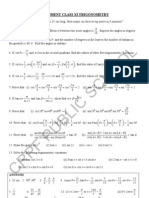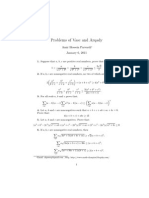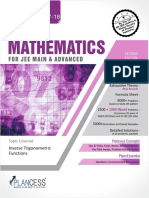Itf Formulae
Uploaded by
A. TraksItf Formulae
Uploaded by
A. TraksM a them a ti cs | 20.
23
PROBLEM-SOLVING TACTICS
•• Making a habit of writing angle values in radians rather in degrees makes the calculation of inverse trigonometric
functions easier.
•• Try to remember graphs of inverse trigonometric functions. Sometimes it is easier to approximate answers
using graphical methods.
•• Always verify whether the results are in the range or domain of the respective function.
•• In some cases, constructing a right angled triangle for the given inverse function and then solving using
properties of triangle is much helpful.
•• In case of identities in inverse circular functions, principal values should be taken. As such signs of x, y, etc.,
will determine the quadrant in which the angles will fall. In order to bring the angles of both sides in the same
quadrant, one should make an adjustment by π .
FORMULAE SHEET
1. If y = sin x, then x = sin‒1 y, similarly for other inverse T-functions.
2. Domain and Range of Inverse T-functions:
Function Domain(D) Range (R)
sin−1 x −1 ≤ x ≤ 1 π π
− ≤ θ ≤
2 2
cos−1 x −1 ≤ x ≤ 1 0 ≤ θ ≤ π
tan−1 x −∞ < x < ∞ π π
− < θ <
2 2
cot −1 x −∞ < x < ∞ 0 < θ < π
sec−1 x x ≤ − 1, x ≥ 1 π
0 ≤ θ ≤ π, θ ≠
2
cosec−1 x x ≤ − 1, x ≥ 1 π π
− ≤ θ ≤ , θ ≠ 0
2 2
3. Properties of Inverse T-functions:
π π
(i) sin−1 (sin θ) = θ provided − ≤ θ ≤
2 2
cos−1 (cos θ) = θ provided 0 ≤ θ ≤ π
π π
tan−1 (tan θ) = θ provided − < θ <
2 2
cot −1 (cot θ) = θ provided 0 < θ < π
2 0 . 2 4 | Inverse Trigonometric Functions
π π
sec−1 (sec θ) = θ provided 0 ≤ θ < or <θ≤π
2 2
π π
co sec−1 (co sec θ) = θ provided − ≤ θ < 0 or 0 < θ ≤
2 2
(ii) (sin−1 x)
sin = x provided − 1 ≤ x ≤ 1
(cos−1 x)
cos = x provided − 1 ≤ x ≤ 1
tan
= (tan−1 x) x provided − ∞ < x < ∞
cot
= (cot −1 x) x provided − ∞ < x < ∞
sec
= (sec−1 x) x provided − ∞ < x ≤ −1 or 1 ≤ x < ∞
−1
cosec (cosec
= x) x provided − ∞ < x ≤ −1 or 1 ≤ x < ∞
(iii) sin−1 ( − x) =
− sin−1 x, π
(iv) sin−1 x + cos−=
1
x , ∀ x ∈ [ −1, 1]
2
cos−1 ( − x) =π − cos−1 x
π
tan−1 ( − x) =
− tan−1 x tan−1 x + cot −1=
x , ∀ x∈ R
2
cot −1 ( − x) = π − cot −1 x π
sec−1 x + cosec−=
1
x , ∀ x ∈ ( −∞ , −1] ∪ [1, ∞ )
cosec −1
( − x) =− cosec −1
x 2
−1 −1
sec ( − x) = π − sec x
4. Value of one inverse function in terms of another inverse function:
−1 x 1 − x2
(i) sin= x cos−1 1 −=
x2 tan−1 = cot −1
1 − x2 x
1 1
= sec−1= cosec−1 , 0 ≤ x ≤ 1
1 − x2 x
1 1 − x2 x
(ii) cos−= x sin−1 1 −=
x2 tan−1 = cot −1
x 1 − x2
1 1
= sec−1= cosec−1 , 0 ≤ x ≤ 1
x 1 − x2
x −1 1 1 1 + x2
=
(iii) tan−1 x sin
= −1
cos
= −1
cot −1= sec x2
1 += cosec−1 , x ≥ 0
1 + x2 1 + x2 x x
1
sin−1
(iv) = cosec−1 x, ∀ x ∈ ( −∞ ,1] ∪ [1, ∞ )
x
−1 1
(v) cos
= sec−1 x, ∀ x ∈ ( −∞ ,1] ∪ [1, ∞ )
x
1 cot −1 x for x > 0
(vi) tan−1 =
x −1
−π + cot x for x < 0
M a them a ti cs | 20.25
5. Formulae for sum and difference of inverse trigonometric function:
−1 x+y
(i) tan= x + tan−1 y tan−1 ; if x > 0, y > 0, xy < 1
1 − xy
x+y
(ii) tan−1 x + tan−1 y = π + tan−1 ; if x > 0, y > 0, xy > 1
1 − xy
−1 −1 −1 x+y
=
(iii) tan x − tan y tan ; if xy > − 1
1 + xy
x−y
(iv) tan−1 x − tan−1 y = π + tan−1 ; if x > 0, y < 0, xy < − 1
1 + xy
x + y + z − xyz
(v) tan−1 x + tan−1 y + tan−1 z =
tan−1
1 − xy − yz − zx
(vi) sin−1 x ± sin
= −1
y sin−1 x 1 − y 2 ± y 1 − x2 ;
2 2
If x, y, ≥ 0 & x + y ≤ 1
(vii) sin
−1
x ± sin−1 y = π − sin−1 x 1 − y 2 ± y 1 − x2 ;
2 2
If x, y, ≥ 0 & x + y > 1
(viii) cos
−1
x ± cos
= −1
y cos−1 xy 1 − x2 1 − y2 ;
2 2
If x, y, > 0 & x + y ≤ 1
(ix) cos−1 x ± cos−1 y = π − cos−1 xy 1 − x2 1 − y2 ;
2 2
If x, y, > 0 & x + y > 1
6. Inverse trigonometric ratios of multiple angles
(i) 2sin−1 x sin−1 (2 x 1 − x2 ), if − 1 ≤ x ≤ 1
=
−1
(ii) 2cos
= x cos−1 (2 x2 − 1), if − 1 ≤ x ≤ 1
−1 −1 2x −1 2x −1
1 − x2
=
(iii) 2 tan x tan
= sin
= cos
1 − x2 1 + x2 1 + x2
−1
(iv) 3sin
= x sin−1 (3x − 4x3 )
−1 −1
3cos x cos
(v) = (4 x3 − 3x)
3x − x3
(vi) 3tan−1 x = tan−1
1 − 3x2
You might also like
- The Online Math Open Fall Contest Official Solutions October 25 - November 5, 2019No ratings yetThe Online Math Open Fall Contest Official Solutions October 25 - November 5, 201925 pages
- The Art of Coordinate Bashing: 1 1 2 2 1 1 y y X X 1 1 2 2 2 1 2 2 1 2No ratings yetThe Art of Coordinate Bashing: 1 1 2 2 1 1 y y X X 1 1 2 2 2 1 2 2 1 24 pages
- The Olympiad Corner: No. 307 Nicolae StrungaruNo ratings yetThe Olympiad Corner: No. 307 Nicolae Strungaru6 pages
- 1967 Geometry Revisited (H.S.M.Coxeter) - (pp.026+159)No ratings yet1967 Geometry Revisited (H.S.M.Coxeter) - (pp.026+159)2 pages
- International Competitions International Zhautykov Olympiad 2006 155No ratings yetInternational Competitions International Zhautykov Olympiad 2006 1552 pages
- Dr. Ujagar Patel Dr. Shishir Kumar Sahoo - Mathematics Olympiad A Problem Solution Set Dr. Ujagar Patel Dr. Shishir Kumar Sahoo RMO INMO IMO Questions and Solutions (1999)No ratings yetDr. Ujagar Patel Dr. Shishir Kumar Sahoo - Mathematics Olympiad A Problem Solution Set Dr. Ujagar Patel Dr. Shishir Kumar Sahoo RMO INMO IMO Questions and Solutions (1999)310 pages
- Geometry - Olympiad Material BY DR SHYAM SUNDAR AGRAWALNo ratings yetGeometry - Olympiad Material BY DR SHYAM SUNDAR AGRAWAL67 pages
- 40 Functional Equations Problem 16 Solution - Adib HasanNo ratings yet40 Functional Equations Problem 16 Solution - Adib Hasan1 page
- Geometry Revision Properties For INMO - 2018100% (1)Geometry Revision Properties For INMO - 201815 pages
- Ramanujan School of Mathematics Isi Entrance Objective Test: Debangshu Ari100% (1)Ramanujan School of Mathematics Isi Entrance Objective Test: Debangshu Ari4 pages
- Rank Refiner IIT JEE Adv. 2020: Good Luck !!No ratings yetRank Refiner IIT JEE Adv. 2020: Good Luck !!3 pages
- Vectors JEE Advanced Questions PDF With SolutionsNo ratings yetVectors JEE Advanced Questions PDF With Solutions32 pages
- The Elements of Coordinate Geometry Part1No ratings yetThe Elements of Coordinate Geometry Part1450 pages
- Junior Problems: Mathematical Reflections (2021) 1No ratings yetJunior Problems: Mathematical Reflections (2021) 14 pages
- Problems Proposed by Vasc and Arqady - Amir Hossein ParvardiNo ratings yetProblems Proposed by Vasc and Arqady - Amir Hossein Parvardi13 pages
- 6.inverse Trigonometric FunctionsTheoryNo ratings yet6.inverse Trigonometric FunctionsTheory25 pages
- A Stability Function For Explicit Evaluation of The Mullins-Sekerka Interface Stability CriterionNo ratings yetA Stability Function For Explicit Evaluation of The Mullins-Sekerka Interface Stability Criterion4 pages
- Chap5 - Representation of Technical InformationNo ratings yetChap5 - Representation of Technical Information32 pages
- Libro Kamala - Formal Languages and ComputationNo ratings yetLibro Kamala - Formal Languages and Computation517 pages
- Bachelor of Computer Science (Hons) 2013-14-1st YearNo ratings yetBachelor of Computer Science (Hons) 2013-14-1st Year10 pages
- XII - 041 - Pre Board - 1 - 23-24 - Set B - Sol (SAPPHIRE INTERNATIONAL SCHOOL, NOIDA)No ratings yetXII - 041 - Pre Board - 1 - 23-24 - Set B - Sol (SAPPHIRE INTERNATIONAL SCHOOL, NOIDA)17 pages
- A 4 Point Interpolatory Subdivision Scheme For Curve DesignNo ratings yetA 4 Point Interpolatory Subdivision Scheme For Curve Design13 pages
- 2023-staar-redesign-algebra-i-practice-testNo ratings yet2023-staar-redesign-algebra-i-practice-test44 pages
- Midterm Exam - Mathematics in The Modern WorldNo ratings yetMidterm Exam - Mathematics in The Modern World17 pages
- BASICCALCULUS_Q3_M2_Basic Concept of DerivativesNo ratings yetBASICCALCULUS_Q3_M2_Basic Concept of Derivatives52 pages
- R014 - How Can I Work On TesysT Custom LogicNo ratings yetR014 - How Can I Work On TesysT Custom Logic15 pages
























































































